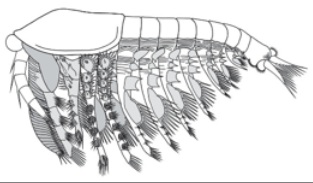
Image from Nature
It may not be obvious, but the creature on the right (Yicaris dianensis) is a big deal. Not in size; at its largest, it appears that Yicaris was only about a millimeter long. Rather, its location makes it noteworthy: it was found in rocks in the early Cambrian, suggesting that true crustaceans are quite a bit older than previous evidence had indicated. Its discovery was reported in this week's issue of Nature.
Crustaceans are well represented in fossils younger than 500 million years, but are largely absent from finds that date to the early Cambrian. But there was evidence to suggest that they should be there; a closely related group, the Phosphatocopina, was present at the time, and some embryos with features that suggested a crustacean identity had also been found. The discovery of Yicaris, however, had to wait for someone willing to risk dissolving Cambrian rocks in acid and sift through the results with a microscope sufficient to detect the tiny creatures. The effort was well rewarded; the search picked up two additional arthropod species, and a number of Yicaris samples at various stages of development.

